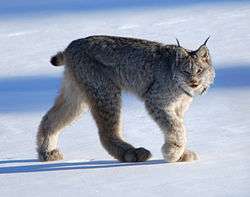Lynx issiodorensis
| Issoire lynx Temporal range: Villafranchian | |
|---|---|
| | |
| Fossils | |
| Scientific classification | |
| Kingdom: | Animalia |
| Phylum: | Chordata |
| Clade: | Synapsida |
| Class: | Mammalia |
| Order: | Carnivora |
| Suborder: | Feliformia |
| Family: | Felidae |
| Genus: | Lynx |
| Species: | †L. issiodorensis |
| Binomial name | |
| Lynx issiodorensis (Croizet & Jobert, 1828) | |
The Issoire lynx (Lynx issiodorensis) is an extinct species of lynx that inhabited Europe during the late Pliocene to Pleistocene epoches, and may have originated in Africa during the late Pliocene.[1] It is named after the town of Issoire where the first remains were found. It probably became extinct during the end of the last glacial period.[1]
It is generally considered as the ancestor of all four species of lynx alive today. Its skeleton resembled that of living lynxes, but it had shorter and more robust limbs, with a larger head and longer neck. As a result, the Issoire lynx more closely resembled a typical member of the cat family than do its extant descendants.
Species descending from Lynx issiodorensis

Bobcat
(Lynx rufus)
Canada lynx
(Lynx canadensis)Eurasian lynx
(Lynx lynx)
Iberian lynx
(Lynx pardinus)
References
- 1 2 Sunquist, Mel; Sunquist, Fiona (2002). Wild cats of the World. Chicago: University of Chicago Press. p. 153. ISBN 0-226-77999-8.
External links
![]() Data related to Lynx issiodorensis at Wikispecies
Data related to Lynx issiodorensis at Wikispecies
This article is issued from
Wikipedia.
The text is licensed under Creative Commons - Attribution - Sharealike.
Additional terms may apply for the media files.